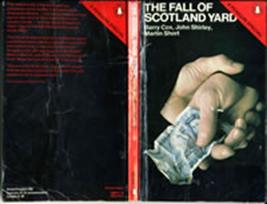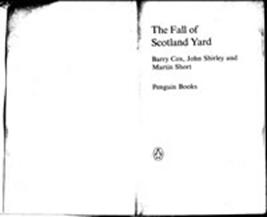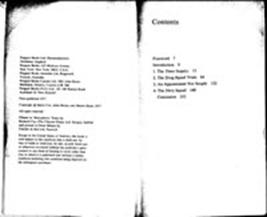|
Foreword
This book has its origins in two television
programmes on which we worked as journalists. The first, a Granada TV
World in Action, was begun in 1970 and concerned the illegal methods
employed by some members of the Metropolitan Police Drug Squad. It was
eventually shown on the ITV network (after many difficulties) on 26 November
1973. The second programme, an investigation of the Soho empires of Bernie
Silver and James Humphreys and their friendships with a number of senior
officers at Scotland Yard (in particular, members of the Flying Squad and
the Obscene Publications Squad) was transmitted by London Weekend
Television’s The London Programme on 8 June 1975.
As research proceeded for the earlier programme,
it became apparent that we were not examining an isolated incident of police
malpractice, but the logical conclusion of an ethic of detective work that
prevailed among wide sections of the London CID. We looked deeper, and began
to realize that a counter-attack against that ethic was already under way,
having been launched by the unlikely combination of a petty criminal (who
didn't know what he was starting) and a senior police officer of the highest
integrity (who did). We followed through the story, and our second programme
was produced in full knowledge of this background. But television is an
ephemeral form, and we believed it important that the full saga of the fall
of Scotland Yard - which was what we were witnessing - should be consigned
to the more permanent medium of print.
Many who have helped us in the preparation of
this book cannot, unfortunately, be named. They include policemen, civil
servants, lawyers and criminals whose anonymity we must respect but whose
confidence in us, we hope, is vindicated by what follows. Margaret Masson,
who typed a lot, deserves our special thanks, as do Neil Middleton and
Geraldine Cook, our editors at Penguins, who have been helpful and immensely
patient throughout the complex business of revision.
We alone are responsible for any factual errors
that have filtered through the process, and for the opinions expressed in
the following pages.
BARRY COX
JOHN SHIRLEY
MARTIN SHORT
July 1977
Introduction
Despite its title, this is not another
anti-police book. Nor, more obviously, does it belong to that genre of
police glorification which is the special preserve of the Fleet Street crime
reporters. This is the kind of book that is more often written about the
worlds of politics, business or international relations than of the police.
Indeed, had the Metropolitan Police appreciated that they too were part of
the increasingly open society that Britain was becoming in the 1960s, other
books devoted to the politics of law enforcement would have appeared before
now, and - who knows - perhaps the events that occasioned this particular
book might never have happened.
The ‘fall’ of Scotland Yard took place between
1969 and 1972. As a result of what happened in those years, a score of
London detectives went to gaol, hundreds more left the force in disgrace and
the old CID hierarchy was savagely restructured. The myth of the London
bobby was badly dented and a long-standing tradition of detective work was
almost completely destroyed. The effects of that crash reverberate today;
though we have chosen to conclude our story with the completion of the
trials of fifteen detectives earlier this year, the real story is of course
not finished. There are still men high up in the reformed Yard who are lucky
to be there.
Since 1969 there have been three major inquiries
into the Metropolitan Police, which have produced in turn five major trials
of London detectives. The first was the inquiry into the allegations made by
The Times about extortion and corruption, which lead to the
imprisonment of two South London detectives in 1972. The second was the
Lancashire police inquiry into members of the Drug Squad, which eventually
resulted in the trial of six Drug Squad detectives, and the gaoling of three
of them, in 1973. Finally there was the mammoth investigation by Deputy
Assistant Commissioner Gilbert Kelland into allegations of widespread
corruption amongst detectives who dealt with the vice world of Soho and
Mayfair. This took more than three years to complete, and resulted in the
discreet dismissal of more than twenty detectives and the trial of the two
most senior Scotland Yard men ever to be brought before the London courts,
ex-Commander Wallace Virgo and ex-Commander Kenneth Drury.
These three episodes form the substance of this
book. The inquiries and trials have not been picked at random, nor selected
simply because they were particularly juicy examples of bent detectives
caught and punished. There is an intimate connection between these events.
Sometimes the connection derives from the overlapping roles of particular
individuals - DCS Moody, for example, who headed the Scotland Yard inquiry
into The Times allegations, was four years later one of the main
subjects of interest in the Kelland inquiry into Soho corruption. More
important, these events played a key part in the power struggle between the
old London CID hierarchy and those - usually outside the Met -who sought to
break the power of that hierarchy. The best-known moment in that power
struggle was the appointment of Robert Mark as the Commissioner in 1972, and
our story will reveal more explicitly than hitherto just why the Government
took the unprecedented step of appointing a uniformed provincial policeman
to the top London job.
Before Mark’s appointment, Scotland Yard’s upper
echelons tolerated, where they did not actively encourage, a system of
detective work that led to a dangerous collusion between the police and
London’s criminals: dangerous, not just because individual detectives were
or became corrupt, or even because innocent or relatively inoffensive people
were the victims of injustice, but because major criminals had secured for
themselves virtual immunity from prosecution. How and why Bernie Silver
escaped serious police attention for so long is not an academic question.
It was the Times front-page articles of
November 1969 which forced both the authorities and the public at large to
consider seriously whether their traditional belief in the virtue of the
London police might not be very much misplaced. Although the corrupt and
vicious career of Detective Sergeant Harry Challenor had been a sensational
cause célèbre in 1963, Challenor conveniently went mad before his
trial, and the old regime at the Yard was able to convince the public that
he was a singular (and insane) rotten apple rather than the tip of a
substantial iceberg. As a result the exhaustive overhaul of London’s CID
that Challenor’s case might have provoked was deferred for several years,
years in which a large number of London detectives grew fat and dangerous.
When the authorities finally had to confront this situation, they found
themselves with the task of dealing not only with detective sergeants and
detective constables behaving corruptly at street level (in itself no easy
task, as we shall show), but with the even greater problem posed by their
superiors - up to commander level - who had come up through the same
lucrative system themselves and were happy to protect subordinates following
in their footsteps.
To tackle this appalling situation, the
Government had to turn to law-enforcement agencies outside London - to
provincial detectives and to the Customs. Even after Mark took over it is
significant that he had to look to East End detectives, led by DCS Albert
Wickstead, to handle the West End.
This book has therefore three objectives: to
describe the pattern of corruption and malpractice revealed by the events
that followed November 1969; to locate these events within the political
struggle between the old regime at Scotland Yard and that regime’s enemies
outside the Yard; and finally to analyse the methods of detection that
destroyed the reputation of Scotland Yard from within. It is too early to
say whether or not the Mark reforms and more recent development (such as the
appointment of David McNee as Mark’s successor) will fully restore that
reputation.
Go to Part 1 |



